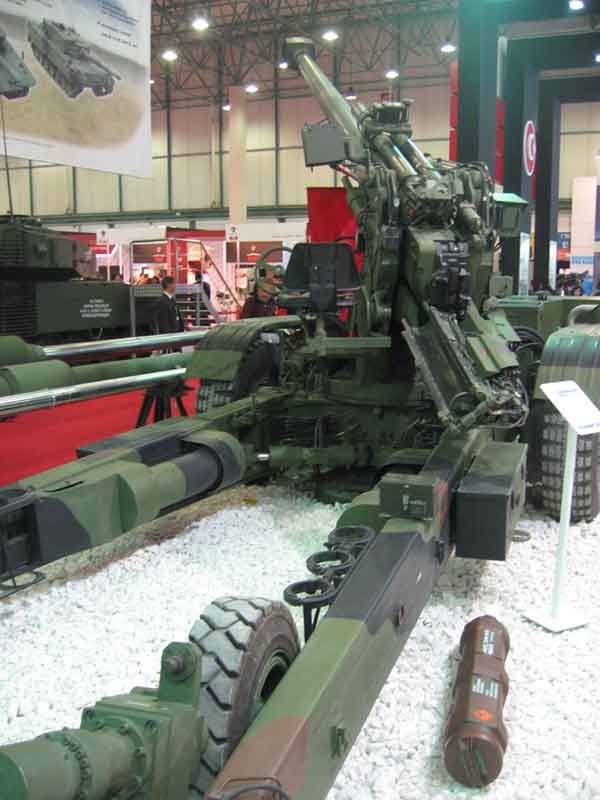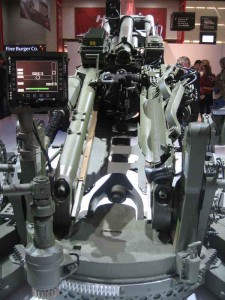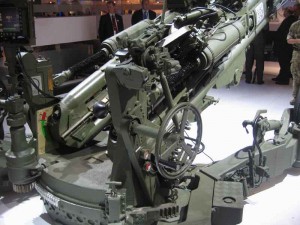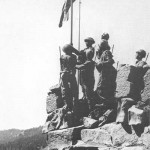
Panter is the Turkish adaptation of the Singapore STK FH2000. it is manufactured under licence by MKE. (photo MC)
Designers have adopted smart materials such as titanium to meet ambitious new goals in terms of air transport capabilities. This light but resilient metal is heavily used in the frame of the gun. All subsystems are manually operated or slightly assisted with a hand pump. For weight reasons, the M777 cannot be fitted with an independent engine that could have provided assistance to the crew. This means that operationally, the battery takes rather a long time to charge before firing the first round.
The Indian artillery corps is still using rather old fire control systems inherited from the Soviet era. The artillery modernisation program requires quicker response times and MRSI capabilities, as well as, brand new guns.
In Spain, General Dynamics European Land Systems- Santa Barbara is promoting its SB 155-52 calibre towed gun. This product is in service in Spain and has been ordered by Colombia for the equipment of a full battalion. The SB 155-52 features an automatic breech block locking system, a hydraulic flick rammer and a 10 igniters revolving box. The SB 155-52 is credited with a high rate of fire, close to ten rounds a minute. It is fully compliant with the JBMOU standard. A crew of seven is required to serve the gun. The SB 155-52 has a self mobility capability provided by a 78 kW diesel engine. Its twin axle allows the gun to move at speeds of up to 18 km/h on tracks and roads. The diesel engine drives a hydraulic pump which provides power to rim mounted hydraulic motors.
An INS attached to a ballistic computer makes the SB 155-52 afully autonomous gun. In addition, muzzle velocity radar can be attached on the cradle as an option.
The gun is rather heavy – almost 14 tonnes – and can only be towed by powerful trucks that also carry crew and ammunitions. In January, the Spanish army shipped some SB 155-52 to the disputed Melilla enclave on the Moroccan coast. These guns equip the Regimiento Mixto de Artilleria 32.
 With the acquisition of the South African company Denel, Rheinmetall added two more artillery system to its portfolio: the towed G5 and the G6 wheeled howitzer. When Denel was blacklisted in India, it tried to do business under the Rheinmetall banner. To do so, Rheinmetall integrated its 155-52 ordnance into the G6. This gun was taken from the PZH 2000 heavy tracked howitzer. A similar same recipe was used with the G5, which was previously fitted with a 45 calibres barrel from a South African original design. The new gun might be a contender in the Indian competition.
With the acquisition of the South African company Denel, Rheinmetall added two more artillery system to its portfolio: the towed G5 and the G6 wheeled howitzer. When Denel was blacklisted in India, it tried to do business under the Rheinmetall banner. To do so, Rheinmetall integrated its 155-52 ordnance into the G6. This gun was taken from the PZH 2000 heavy tracked howitzer. A similar same recipe was used with the G5, which was previously fitted with a 45 calibres barrel from a South African original design. The new gun might be a contender in the Indian competition.
The Turkish army has started a large modernisation program aimed at replacing aging ‘60s assets with new pieces of modern equipment. The artillery corps has already received dozens of Firtina 155-52 tracked howitzers, a system produced under a South Korean licence granted by Samsung. The Firtina is supplemented by the towed MKE 155-52 Panther gun, also produced under the licence of STK in Singapore. The MKE 155-52 gun is in fact the FH 2000. MKE is the prime contractor of the Panther. The Panther features a diesel engine which gives autonomous mobility and assistance to the crew during the crucial phase of setting in and out of battery. As with all 52 calibre guns, the Panther can reach a range of 40 km with dedicated rounds that can withstand the pressure and the acceleration generated by the charge 6 of the JBMOU. The Turkish army is currently firing South Korean shells from Doosan. MKE is developing an indigenous family of 155 rounds and the associated propelling charges. The Turkish company is also seeking to provide those rounds with some kind of insensitive explosive to reduce hazards on the battlefield, and especially in the supply chain. The first proof of principle rounds were fired last year, and full scale development and qualification trials are expected to be completed within two years. Denel is also involved in the Turkish ammunition program by supplying the base bleed technology crucial for the full range.
 Patria is another major European player in the field of towed artillery systems. The Finnish manufacturer has supplied hundreds of pieces to the Finnish Defence Forces. The Finnish artillery corps is still one the biggest in Europe, if not the biggest. The Finnish strategic position has always been to put the artillery in front of the potential threat, namely Russia. The Patria 155 GH 52 APU features a classical design able to cope with the severe local climatic conditions. Its 52 calibre barrel is able to propel a regular 155 round up to40 kilometres. The APU is based on a Deutz diesel engine of 78 kW. Fifty six pieces of 155 GH 52 APU, known in the Finnish army as 155 K98, have been manufactured for the national market. They equip the Kainuu artillery regiment and the artillery brigade in Niinisalo.
Patria is another major European player in the field of towed artillery systems. The Finnish manufacturer has supplied hundreds of pieces to the Finnish Defence Forces. The Finnish artillery corps is still one the biggest in Europe, if not the biggest. The Finnish strategic position has always been to put the artillery in front of the potential threat, namely Russia. The Patria 155 GH 52 APU features a classical design able to cope with the severe local climatic conditions. Its 52 calibre barrel is able to propel a regular 155 round up to40 kilometres. The APU is based on a Deutz diesel engine of 78 kW. Fifty six pieces of 155 GH 52 APU, known in the Finnish army as 155 K98, have been manufactured for the national market. They equip the Kainuu artillery regiment and the artillery brigade in Niinisalo.
In early 2000, Patria signed a licence agreement with Egypt. The TDP of the oscillating part of the 155 GH 52 APU was sold to Military Production, a branch of the Egyptian Ministry of Defence. The project consisted in designing a self propelled gun based on a T55 chassis and the Finnish gun. The concept was close to the old French F3 based on AMX13.
With a rear located power pack, the T55 was not suitable for such a design. Furthermore, the Finnish TDP proved to be irrelevant for the application and the project failed.




